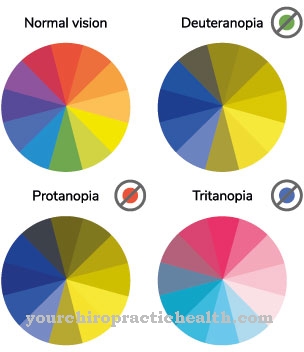osteoporosis respectively Bone loss is one of the most common bone diseases in our country. This leads to a sharp decrease in bone mass, which in the course of the process leads to damage to the bone mass and bone structure. These disorders then have an impact on bone function, so that bone fractures are common. Osteoporosis or bone loss can be prevented relatively well with a balanced diet rich in calcium. Sport and a lot of exercise also help against this disease.
What is osteoporosis?
osteoporosis or. Bone loss causes the patient's bones to become porous and lose weight faster than normal. Compared to healthy people, the relationship between bone growth and bone loss is no longer correct in those affected by osteoporosis.
At the onset of the disease, patients hardly feel any psychological stress, as there are almost no symptoms. Only when the bone mass continues to decrease can fractures suddenly occur without cause, which of course are associated with further pain. As a result of the fractures, an incorrect posture is often assumed to protect the patient and muscular tension develops.
With the progression of osteoporosis, those affected are no longer able to cope with everyday life on their own and therefore often need help.
causes
As with many other medical conditions, there is for osteoporosis not a fundamental cause, rather there are many factors that can lead to an onset of the disease. In general, it can be said that with this disease there is a disturbance in the metabolism of the bones, so that the structure of the bones is no longer guaranteed until the age of 40, as is usual in healthy people.
Risks that can lead to osteoporosis are, for example, underweight or a vitamin deficiency. Too little exercise and an unhealthy lifestyle, such as smoking or taking various medications, can also promote the disease. Often one also finds previous illnesses such as diabetes or a functional disorder of the kidneys in those affected.
It has now been shown that women are more at risk than men, which is mainly due to a lack of estrogen. In some cases, osteoporosis is also genetically inherited.
Typical symptoms & signs
.jpg)
The osteoporosis develops slowly, so that at the beginning of the disease there are hardly any symptoms. Only in the further course does diffuse complaints arise, which those affected often do not associate with the bone loss. Osteoporosis can initially make itself felt as back pain or pain in the knee joints.
Broken bones for no apparent reason, so-called spontaneous fractures, are also among the first symptoms of osteoporosis. In the advanced stage of bone loss, spontaneous fractures increase. Characteristically, the femoral neck, the vertebral bodies and the upper and lower arms are particularly often affected by a fracture.
Misalignments of the relevant extremities and severe pain may indicate a fracture. The vertebral body fracture, in particular, often appears as a creeping break. Those affected do not notice the fracture of the vertebral body because it causes little or no pain. If there are multiple fractures in the spine, a hunched back can develop.
This is also known as a widow's hump in colloquial language. People with advanced osteoporosis can even lose several inches of height due to the vertebral fractures. In principle, persistent back pain, a decrease in height and a tendency to fracture bones are all indicators of osteoporosis.
Course of disease
osteoporosis is chronic, but can be reduced if the disease is treated in time. However, if it is detected too late or if it is treated incorrectly, serious consequences can result. Frequent bone fractures and pain occur as well as a curvature of the back.
In most cases, body size also decreases. For fear of renewed pain, many patients try to take it easy, but this only leads to further incorrect posture and causes further pain through tension. The symptoms can mean that the person affected is considerably restricted in their everyday life and can no longer cope without the help of relatives or carers. A timely diagnosis and the correct treatment of osteoporosis are therefore all the more important.
Complications
The most common complications associated with osteoporosis are dangerous bone fractures in old age. A fracture of the femur neck is to be expected with particularly serious consequences. In patients older than 70 years, this fracture leads to death in almost a third of all cases. Around half of all those affected no longer fully recover and remain in need of care for the rest of their lives.
Postural damage is also a common complication of osteoporosis. The so-called "widow's hump" is particularly characteristic. Most of the patients suffer from this mentally because of their deformed external appearance. But there are usually physical impairments as well. Due to the strong curvature of the spine, the chest cavity becomes smaller, which is regularly associated with breathing disorders, which in turn lead to shortness of breath and, in rare cases, serious lung diseases.
If the osteoporosis is not treated in a timely manner and if it progresses significantly, a number of other complications can be expected in addition to impaired breathing. The poor posture often causes chronic pain and severely restricts mobility, which makes it difficult to cope with everyday life and participate in social life. The reduction in quality of life can also cause depression. To prevent this negative spiral, treatment for osteoporosis should be started as early as possible.
When should you go to the doctor?
If you already have osteoporosis, you should always consult an appropriate doctor so that bone loss can be counteracted. Osteoporosis causes bone density to decrease faster than usual. To be able to counteract this effect, medical and drug treatment should be sought as soon as possible. Anyone who decides on such treatment at an early stage can count on a quick and effective improvement. However, osteoporosis cannot be completely cured.
Bone density can be delayed with dietary supplements and other preparations so that the life of the person concerned can be made much more comfortable. If the visit to the doctor is delayed in the event of osteoporosis, serious complications can arise. The bones become weaker and more fragile every day, so that even the slightest stress can lead to a fracture. So the following applies: At the first signs of osteoporosis, a doctor should be consulted as soon as possible. Only in this way can a treatment be initiated that counteracts bone loss and slows it down significantly. If medical and drug treatment is completely dispensed with, life-threatening complications can sometimes occur.
Treatment & Therapy
Depending on the stage at which the osteoporosis When diagnosed and how it progresses, so is treatment. The main aim of therapy is to improve the metabolism of the bones. In addition, drugs are mainly used to make the pain bearable for those affected.
If osteoporosis is recognized in a state where bone loss has not progressed so far, there is a good chance that this process can at least be slowed down. Treatment also involves changing your diet. The calcium contained in many foods, for example, strengthens the bones and should therefore be taken in larger quantities. Vitamin D also helps to reduce the symptoms of osteoporosis.
Aftercare
After the treatment and rehabilitation, the patient receives therapy and follow-up recommendations for the treating family doctor. The main priority is to continue drug osteoporosis therapy and physiotherapeutic measures. An individual aftercare program is put together for the patient. This also includes physiotherapy and occupational therapy prescriptions.
The use of aids is checked and constantly adapted to the changed circumstances of the patient. Follow-up care is always necessary and sensible for osteoporosis. On the one hand, this means that the treatment is individually adapted to the patient's current pain symptoms. On the other hand, therapeutic measures for physical exercise are appropriately designed.
As part of the follow-up examinations, continuously adapted drug therapy is carried out. The bone mass of the patient with osteoporosis is measured and determined by means of continuous follow-up examinations. The estrogen treatment, which is carried out until the end of life, is monitored by the doctor.
Appropriate follow-up care can largely prevent spontaneous fractures by making the patient's everyday life safe. This includes, for example, sturdy, comfortable shoes and non-slip floors, but also aids such as glasses for those with visual impairments. Another therapeutic approach in aftercare is an adapted, balanced diet. Patients with osteoporosis should always have a sufficient supply of vitamin D and calcium. This should be done either through appropriate foods or by taking nutritional supplements.
Outlook & forecast
Since osteoporosis is an irreversible process, there is no prospect of complete healing of damage that has already occurred. The primary aim is to stop bone loss and the tendency towards fragility of the skeleton and susceptibility to pain in general. Because of the strongly fluctuating symptoms and long-term treatment, strict adherence to therapeutic measures is necessary for a good prognosis. Patients must therefore take regular check-ups and take the prescribed medication, even if they are only mildly disturbed.
If the treatment is not carried out properly, there is a risk of continual deterioration of the bone substance. Patients lose height, show deformations in their posture and later suffer from sometimes severe bone pain. Without consistent therapy, broken bones in particular pose a great danger for those affected in old age. In the worst case, secondary diseases and an increased risk of further injuries in the affected regions lead to the need for care or death. In general, the likelihood of a manifested restriction of movement increases despite surgical interventions.
Often with new fractures rebleeding and a reduced ability to heal wounds occur. For patients, this also means a sharp increase in the personal surgical risk. The mortality rate from the age of 70 with a femoral neck fracture is around 20 percent. Conscientious prevention prevents the development of pronounced bone loss. In the case of already existing osteoporosis, the course can be specifically influenced. Subsequent complications and pain will not occur with timely treatment.
You can do that yourself
A diet rich in calcium prevents osteoporosis and can have a beneficial effect on existing bone loss. A sufficient intake of vitamin D is also important so that the important mineral can be stored in the bones. Magnesium and vitamins K, C and B6 also contribute to bone health. A balanced diet with plenty of fresh fruit, vegetables, whole grain and dairy products usually provides the body with enough vital substances; the intake of food supplements may occasionally be indicated.
Osteoporosis patients should avoid excessive consumption of foods and beverages that are rich in "calcium robbers" such as phosphate and oxalic acid: These include cola, preserved sausage and meat products, spinach, beetroot, Swiss chard and rhubarb. Excessive consumption of caffeine and alcohol also has a negative effect on calcium metabolism.
Exercise is an important part of osteoporosis therapy. Sports with a low risk of injury, such as walking, jogging or swimming, are well suited, but team and martial arts are not recommended. In addition, the muscles can be strengthened with the help of special gymnastic exercises and the entire musculoskeletal system stabilized. In everyday life it is important to avoid falls: In the living area, all tripping hazards should be eliminated, in the bathroom rubber mats reduce the risk of slipping. Good lighting ensures greater safety at night.



.jpg)
.jpg)
.jpg)


.jpg)



















